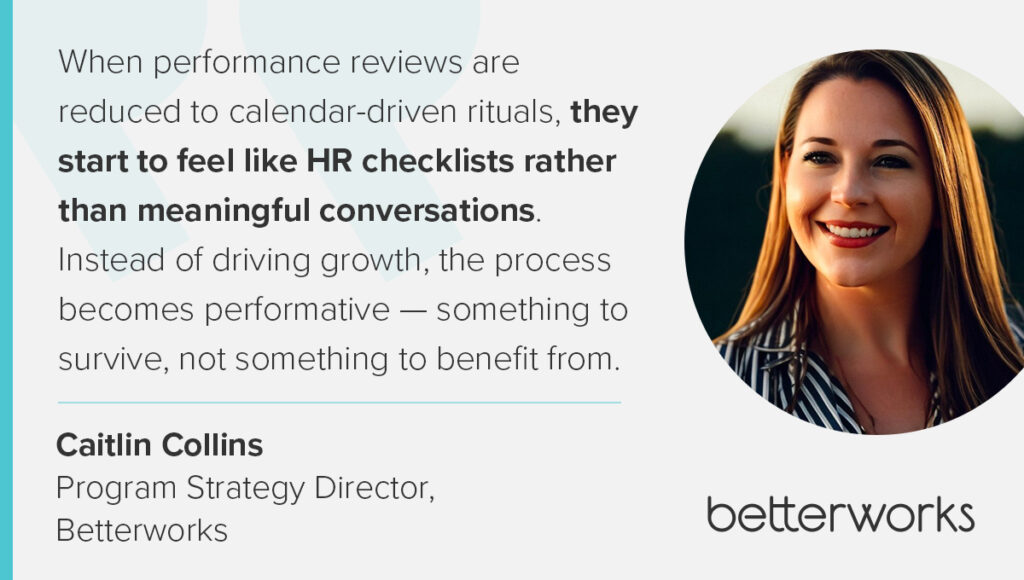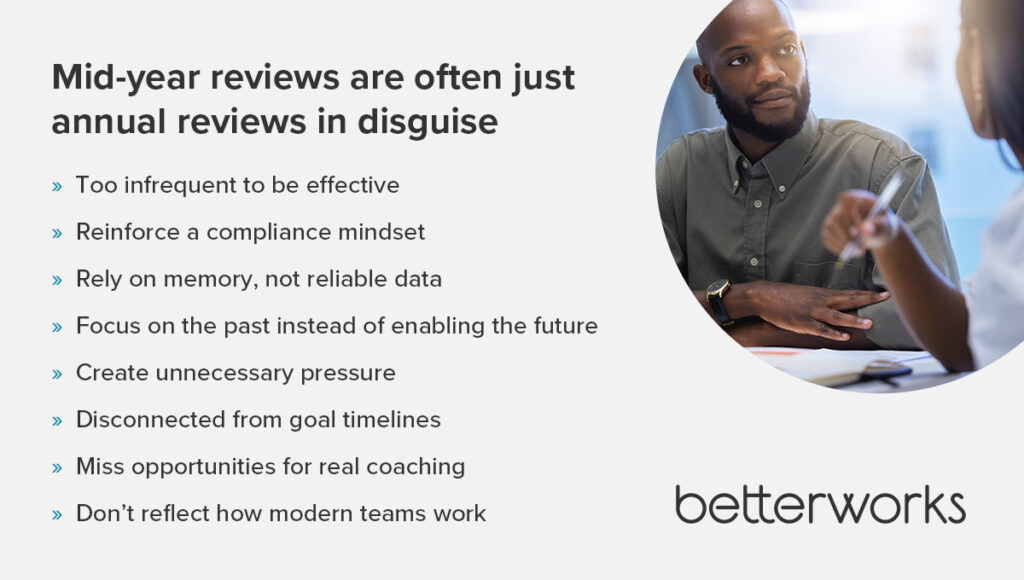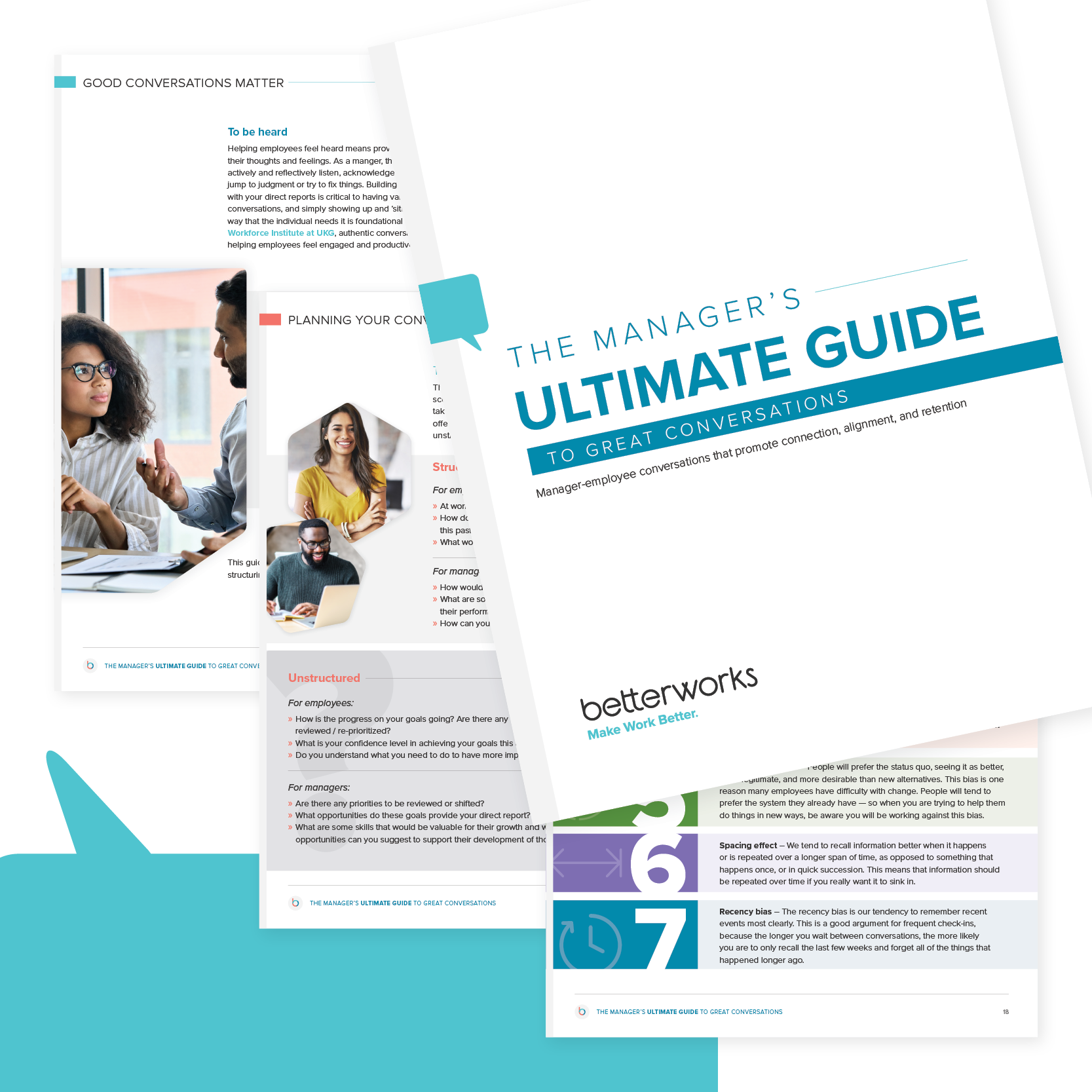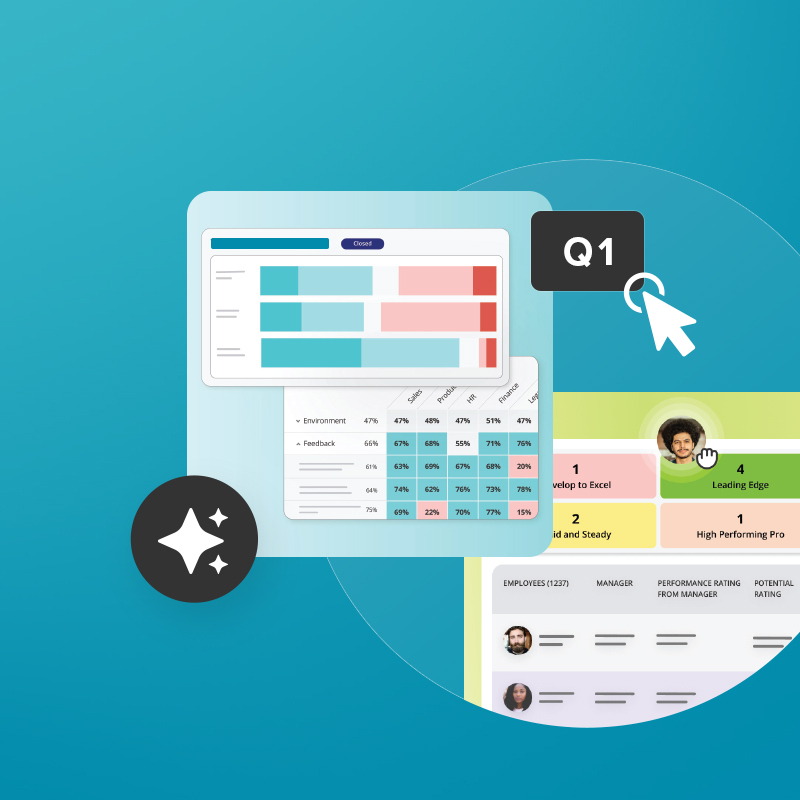- Mid-year reviews are often just annual reviews in disguise
- They’re too infrequent to be effective
- They reinforce a compliance mindset
- They rely on memory, not reliable data
- They focus on the past instead of enabling the future
- They create unnecessary pressure
- They’re disconnected from goal timelines
- They miss opportunities for real coaching
- They don’t reflect how modern teams work
- What HR leaders should do instead of mid-year reviews
- Mid-year review examples for managers (that actually work inside a continuous performance model)
- 1. Reflect on progress toward goals
- 2. Spot performance patterns
- 3. Connect work to business outcomes
- 4. Uncover development opportunities
- 5. Focus forward
- 6. Calibrate expectations
- 7. Revisit and refine outdated goals
- 8. Celebrate overlooked wins
- 9. Assess support systems
- 10. Invite feedback on leadership
- 11. Strengthen cross-functional collaboration
- 12. Clarify decision-making and autonomy
- 13. Align on long-term career growth
- Replace mid-year reviews with a more dynamic system
- Build a high-performing workforce
If your managers are Googling “mid year review examples,” there’s a good chance something’s broken in your performance process.
When performance conversations only happen twice a year and there’s no system in place for regular feedback, even your best managers start looking for scripts. And when those conversations lack context or consistency, they stop being useful altogether.
A manager searching for performance review examples isn’t unprepared — they’re unsupported. The problem isn’t the people – it’s the model. Traditional mid-year reviews often ask managers to do too much with too little, too late.
Mid-year reviews can still serve a purpose, but only when they’re part of a continuous performance management system that turns isolated conversations into a reliable rhythm of feedback, alignment, and growth.
Mid-year reviews are often just annual reviews in disguise
Twice-a-year reviews may seem like a balanced approach — but they carry many of the same issues as outdated annual performance reviews.
They’re too infrequent to be effective
Six months is a long time in any business, especially in fast-paced or high-growth environments. By the time a mid-year review happens, much of the relevant work is already in the rearview mirror — and the conversation ends up being a recap instead of a tool for real-time alignment. Opportunities for in-the-moment feedback or course correction are lost. As a result, performance conversations feel disconnected from what’s actually happening day-to-day.
They reinforce a compliance mindset
“When performance reviews are reduced to calendar-driven rituals, they start to feel like HR checklists rather than meaningful conversations,” says Caitlin Collins, program strategy director at Betterworks. Managers may default to filling out forms or copying generic phrases, and employees start preparing answers they think they’re “supposed” to give. “Instead of driving growth, the process becomes performative — something to survive, not something to benefit from,” Caitlin explains.

They rely on memory, not reliable data
Without a structured system for tracking performance trends and feedback over time, mid-year reviews force managers to rely on their memory. This leads to unconscious bias, such as recency bias, unintentional omissions, and subjective judgments that can erode trust. Employees may feel their most important work was overlooked or that isolated mistakes were given too much weight.
They focus on the past instead of enabling the future
Traditional mid-year reviews are backward-looking by design. But if the goal is to help employees grow, the conversation needs to be about what’s next. A feedback loop that’s always trailing behind can’t fuel future success. Continuous performance systems, by contrast, prioritize future-oriented coaching and goal setting — helping employees take action in real time.
They create unnecessary pressure
When performance conversations happen only once or twice a year, they become high-stakes events. Employees may feel anxious, managers may over-prepare or under-deliver, and neither party walks away feeling energized. “In a continuous feedback environment, reviews are less stressful because they’re just one piece of a larger, ongoing dialogue,” Caitlin says.
They’re disconnected from goal timelines
Most performance goals don’t follow a six- or twelve-month schedule — they evolve with the business. When reviews are rigidly tied to the calendar, they miss the mark. Employees may feel punished for working toward outdated objectives or confused about how to adjust mid-cycle. A continuous approach allows goals to be revisited and recalibrated as things change.
They miss opportunities for real coaching
One of the most valuable aspects of performance enablement is regular, actionable coaching. But mid-year reviews tend to emphasize evaluation over development. Without ongoing check-ins, managers can’t spot patterns early, reinforce good habits, or help employees build new skills in context. Coaching becomes reactive, not proactive — and that limits growth for everyone involved.
They don’t reflect how modern teams work
Static review cycles are out of sync with how most teams operate today. Work is agile, distributed, and constantly shifting. Mid-year reviews are a legacy structure built for a slower, more predictable pace of business. To drive real performance, organizations need systems that support real-time communication, flexibility, and transparency — something mid-year reviews simply weren’t designed to do.

What HR leaders should do instead of mid-year reviews
A high-performing organization doesn’t rely on two conversations a year to guide employee growth. It invests in a continuous performance management process that supports feedback, alignment, and coaching all year long.
This model isn’t just about increasing the frequency of reviews. It’s about replacing static, compliance-driven cycles with an agile performance review process designed to reflect how work actually gets done. It enables employees and managers to move beyond the anxiety of performance reviews and into real-time performance enablement with the tools and structures needed to sustain it at scale.
Here’s what that shift looks like in practice.
Frequent, lightweight check-ins tied to business cadence
Instead of waiting six months to assess progress, high-performing organizations build feedback into the rhythm of work. Feedback is short, consistent, and aligned with team and company cycles, whether that’s monthly sprints, quarterly goals, or strategic planning windows. It allows for more timely course corrections, faster recognition of wins, and better communication between managers and their teams.
Clear goal alignment that adapts to change
In a continuous model, setting goals isn’t a once-a-year activity—it’s a living process. Employees work toward goals that are connected to business priorities and can evolve as those priorities shift. This approach supports clarity and agility at the same time: teams know what they’re working toward, and they can pivot when they need to. Managers aren’t just checking off goals during a review—they’re actively coaching employees to reach them.
Real-time performance insights, not guesswork
When performance data is captured continuously, conversations become more informed and objective. Managers no longer have to rely on memory or gut feeling — they have access to ongoing modern HR metrics — qualitative and quantitative data reflecting feedback, goal progress, peer input, and productivity trends. This improves the quality of evaluations and reduces bias, especially during key talent decisions like promotions, raises, and role changes.
Manager enablement that builds confidence and consistency
Continuous performance management doesn’t work without manager buy-in. That’s why enablement is critical. Instead of giving managers a template to copy during review season, give them coaching tools and frameworks they can use throughout the year. Help them get better at delivering specific feedback, guiding career development, and having tough conversations — so reviews become a natural extension of how they already lead.
A shared responsibility for growth
Perhaps most important, continuous performance management shifts the responsibility for growth from HR alone to a shared commitment between employees, managers, and leadership. Employees are encouraged to speak up about their development goals. Managers are empowered to coach in the moment. And HR teams can focus on building systems that support sustained performance, not just once-a-year processes.
When performance is managed continuously:
- Employees stay more engaged because they know where they stand and where they’re headed: Among employees who have good performance conversations with managers, 81% say they’re always productive and 73% report being always engaged, according to the 2023 Betterworks State of Performance Enablement report.
- Managers become more effective coaches, not just evaluators: when managers connect with employees, the latter are 2.8x more likely to rate their managers as highly effective, says RedThread Research in 2024 research on trends in manager practices.
- Teams stay aligned, even when priorities shift: When employees get the right level of manager conversations, they are 13x more likely to feel aligned on goals, leading to an increase of 35 points in their efficiency and productivity, according to the 2024 Betterworks State of Performance Enablement report.
- The work environment becomes more trusting, transparent, and resilient: When employees view performance management as a success, trust in managers doubles and trust in HR and organizational leaders quadruples, according to the 2023 Betterworks report.

Mid-year review examples for managers (that actually work inside a continuous performance model)
When supported by a continuous feedback loop, a mid-year check-in becomes a strategic opportunity to reflect, recalibrate, and re-energize. It’s also a clear moment to acknowledge strengths, recognize impact, and identify areas of improvement — all in the context of future goals.
One of the most powerful things a manager can do during a review is to encourage employee growth through open-ended, forward-looking questions. These kinds of conversations help build trust and clarity over time.
Here are 13 examples that reinforce a culture of clarity, growth, and accountability.
1. Reflect on progress toward goals
“Looking at the goals we set earlier this year, where have you made the most progress? Where do you feel blocked?”
What to bring: Key results, goal tracking, notes from check-ins
Avoid: Discussing outdated or irrelevant goals
What it sounds like: “I’m 80% toward the Q2 product milestone. The blocker is cross-team alignment — we flagged this last month.”
2. Spot performance patterns
“What strengths have you consistently demonstrated this year? Any recurring challenges we should address?”
What to bring: Output data, 1:1 notes, previous reviews
Avoid: Generalizations—focus on behavior and outcomes
What it sounds like: “You’ve consistently exceeded expectations in client handoffs, but onboarding timelines remain tight.”
3. Connect work to business outcomes
“How has your work supported team or company goals over the last six months?”
What to bring: OKR dashboards, project summaries
Avoid: Praise without context
What it sounds like: “Improving the ticket triage process directly contributed to our Q1 response time target.”
4. Uncover development opportunities
“What skills or experiences would help you grow in the second half of the year?”
What to bring: Role expectations, past feedback
Avoid: Vague next steps — link to development goals
What it sounds like: “I’d like more visibility into client strategy meetings to build my consultative selling approach.”
5. Focus forward
“What would success look like in the next quarter?”
What to bring: Future project roadmap, team goals
Avoid: Only reviewing past performance
What it sounds like: “I’d like to lead the pilot rollout for the new platform and document the learning process.”
6. Calibrate expectations
“Do you feel clear on what’s expected in your role? Are the goals realistic?”
What to bring: Job description, team structure, historical goal progress
Avoid: Ambiguity — give specific feedback when expectations shift
What it sounds like: “The new reporting structure changes my scope — let’s redefine what success looks like for this review period.”
7. Revisit and refine outdated goals
“Which goals no longer align with our priorities?”
What to bring: Strategy updates, reorg context
Avoid: Treating goal plans as static
What it sounds like: “With our pivot to mid-market clients, I’d like to adjust my outreach KPIs.”
8. Celebrate overlooked wins
“What contributions are you proud of that don’t show up in metrics?”
What to bring: Recognition data, team feedback
Avoid: Only tracking high-visibility work
What it sounds like: “Helping onboard two new engineers wasn’t part of my role, but it improved team velocity and the work environment.”
9. Assess support systems
“Do you have what you need to maintain your performance?”
What to bring: Resourcing plans, past blockers
Avoid: Assuming no feedback means things are fine
What it sounds like: “I need better access to product documentation to support my problem- solving skills during implementation calls.”
10. Invite feedback on leadership
“How can I better support your development?”
What to bring: Past 1:1 notes, peer feedback, surveys
Avoid: Asking but not acting
What it sounds like: “You’re great at course-correcting. More context up front would help with meeting deadlines.”
11. Strengthen cross-functional collaboration
“How have you worked with other teams this year? What made those partnerships effective—or frustrating?”
What to bring: Notes from cross-functional projects, team feedback, project outcomes
Avoid: Vague references to “communication issues” — dig into specifics
What it sounds like: “I collaborated with the marketing team on the launch, but our timelines didn’t align. A shared planning doc would’ve helped us move faster.”
12. Clarify decision-making and autonomy
“Where did you take initiative this year? When did you feel empowered to make decisions—and when didn’t you?”
What to bring: Notes from previous check-ins, examples of ownership, feedback loops
Avoid: Assuming empowerment is obvious—experience can vary widely
What it sounds like: “I felt confident owning the new onboarding workflow, but I wasn’t sure who to involve for final sign-off on the dashboard redesign.”
13. Align on long-term career growth
“Are we supporting your long-term goals? What would help you feel more invested in your future here?”
What to bring: Notes on professional development conversations, L&D resources, internal mobility options
Avoid: Making this about retention only—this is about mutual investment
What it sounds like: “I’d like to explore a management path, but I’m not sure what skills I need to build or what opportunities exist internally.”
These conversations don’t just cover the same ground as typical performance review examples. They reinforce clarity, capability, and connection. A well-run mid-year review inside a continuous system deepens trust, encourages feedback, and builds momentum toward the right outcomes.
Replace mid-year reviews with a more dynamic system
When teams operate in fast-paced, goal-driven environments, performance conversations can’t be tethered to a twice-a-year cycle. Static systems struggle to keep up with shifting priorities, team dynamics, and real-time development needs.
A more dynamic approach empowers teams with:
- Feedback in the flow of work
- Clear goals tied to evolving strategy
- Frequent, low-friction conversations
- Confidence in the performance evaluation process
Betterworks helps organizations move from review-as-event to performance enablement as a system. The result is a culture where employees don’t just meet expectations — they grow, adapt, and contribute more meaningfully every day.
Build a high-performing workforce
Modern teams need agile feedback, clear goals, and real-time coaching. Learn how continuous performance enablement fuels success.
Book a demo.
See how Betterworks delivers performance results that advance business goals





